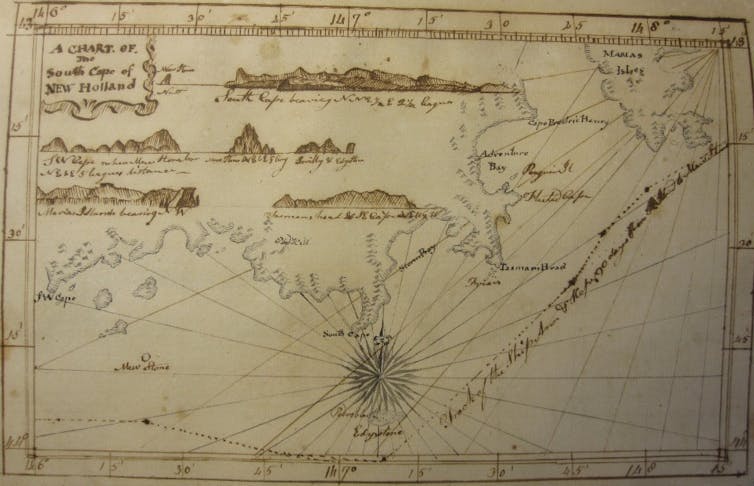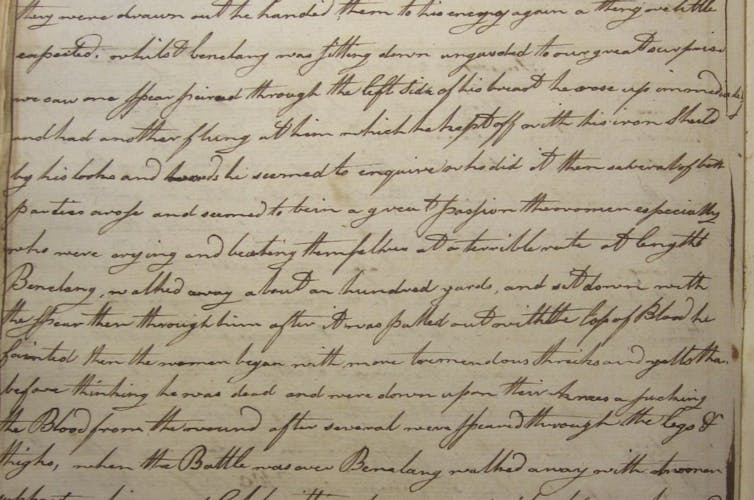Sailors' journals shed new light on Bennelong, a man misunderstood by history
- Written by Brett Goodin, Postdoctoral fellow in the Program in Early American Economy & Society, at the Library Company of Philadelphia.., Australian National University
The natives of new Holland are perhaps the quickest fighters in the world … They remind me of Homer’s description of his heroes. The warriors throw themselves into the same attitudes, they harangue, they brandish and cast their spears in a manner similar to that described by the celebrated poet, “so saying, swaying back and forth, he launched his long-shadowed spear”.
-Benjamin Bowen Carter , 1798
This laudatory account of a group of Indigenous Australians, including Woollarawarre Bennelong, has been collecting dust in Rhode Island since 1798, when the fledgling United States was just beginning to stretch into the Asia-Pacific region, led by private merchant sailors.
It is contained in one of two 220-year-old journals from the merchant ship Ann & Hope (held in the John Carter Brown Library and the Rhode Island Historical Society respectively) penned by sailors Benjamin Page, Jr. the teenage son of the ship’s captain and Benjamin Bowen Carter, the ship’s surgeon.
They have been largely forgotten by historians, bar one or two, but shed light on Bennelong in particular: a celebrated yet misunderstood man. For much of white Australian history, Bennelong was portrayed as a tragic victim of alcoholism and cultural homelessness. Captured in November 1789 under orders from Governor Arthur Phillip to be taught English and serve as a cultural intermediary, he was later taken to England, returning to his homeland in 1795.
In their 11-month journey around the world, the Ann & Hope’s crew spent just four days in Sydney. But Page and Carter wrote thousands of words about New Holland’s people, environment, and trading prospects. Chief among their fascinations was witnessing Bennelong adjudicate an unusually messy payback punishment, which they recorded in excruciating and bloody detail.
 Benjamin Page Jr., Ann & Hope logbook, 1798-1799, Brown & Ives Records, Box 715, folder 1, John Carter Brown Library, Rhode Island.
Author provided.
Benjamin Page Jr., Ann & Hope logbook, 1798-1799, Brown & Ives Records, Box 715, folder 1, John Carter Brown Library, Rhode Island.
Author provided.
In doing so, they inadvertently reveal that Bennelong continued to hold positions of authority long after his return from the UK – in contrast to accounts by many eminent historians and popular authors that depicted him as lost between two worlds, comfortable in neither.
According to writer and academic Deborah Bird Rose, in Aboriginal communities,
reciprocity designed to re-establish social relations ruptured by wrong-doing is called ‘payback’. It is physical violence that is expected to be roughly equivalent to the offence. Its purpose is to restore a sense of balance and to effect a form of closure.
Echoing this desire for balance, Carter observed in 1798 that:
The generosity of these people is singular. When their enemies have discharged their spears, they will return them and prepare themselves for another assault. They frequently during the battle ran up to the opposite party and received their spears from the enemy. Nor did their antagonists throw a foul spear or improve in the least the advantage put into their hands, of killing an enemy when alone or unguarded.
Unfortunately, this protocol went awry when Bennelong decreed (apparently unconvincingly) that the appropriate punishment had been met.
He was violently rebuffed and, according to Page:
Whilst Bennelong was sitting down unguarded to our great surprise we saw one spear pierced through the left side of his breast he rose up immediately and had another flung at him which he kept off with his iron shield by his looks and words he seemed to enquire who did it then several of both parties arose and seemed to be in a great passion the women especially who were crying and beating themselves at a terrible rate at length.
Bennelong walked away about a hundred yards and sat down with the spear then through him after it was pulled out with the loss of blood he fainted then the women began with more tremendous shrieks and yells than before thinking he was dead and were down upon their knees a sucking the blood from the wound after several were speared through the legs & thighs.
 Benjamin Page Jr., Ann & Hope logbook, 1798-1799, Brown & Ives Records, Box 715, folder 1, John Carter Brown Library, Rhode Island.
Author provided
Benjamin Page Jr., Ann & Hope logbook, 1798-1799, Brown & Ives Records, Box 715, folder 1, John Carter Brown Library, Rhode Island.
Author provided
Nearly being killed while adjudicating a payback punishment does not paint Bennelong in the most favourable light. But the fact that as late as 1798 he was given the honour of adjudicating such a ceremony challenges much of the outdated historiography about him.
Bennelong has been mistakenly remembered for centuries, encouraged by national institutions such as the Australian Dictionary of Biography. The dictionary is currently rewriting its entry on Bennelong and other Indigenous Australians to reflect the new findings of scholars such as Shino Konishi, Keith Vincent Smith, Kate Fullagar, and Emma Dortins.
Read more: Indigenous lives, the 'cult of forgetfulness' and the Australian Dictionary of Biography
Bennelong’s 1966 entry in the dictionary is especially careless for highlighting how, after being the first Aboriginal man to visit England in 1792, he returned to Sydney,
and thereafter references to him are scanty, though it is clear that he could no longer find contentment or full acceptance either among his countrymen or the white men. Two years later he had become “so fond of drinking that he lost no opportunity of being intoxicated, and in that state was so savage and violent as to be capable of any mischief”.
Less disparagingly, Inga Clendinnen argues that, after returning from Europe, Bennelong, “with his anger and his anguish, simply drops from British notice”.
In reality, he dropped from official British records, but certainly not from positions of authority or from visiting American sailors’ notice.
The New South Wales government’s pledge to build a memorial on the land where Bennelong is buried certainly could not come at a better time.
Meanwhile, historians who have been diligently rewriting Bennelong’s history are finally being written about in the mainstream press. And who knows, maybe there are more dusty journals scattered around the world that will contribute to this rewriting over the next 200 years.
The author thanks Josiah Ober of Stanford University for translating from Greek the Iliad quote at the top of this page.
Authors: Brett Goodin, Postdoctoral fellow in the Program in Early American Economy & Society, at the Library Company of Philadelphia.., Australian National University





